Experience the Magic of Japanese Summer: Your Complete Guide to Wearing Yukata at Fireworks Festivals
Japan’s summer season offers an extraordinary cultural immersion that combines ancient traditions with spectacular modern celebrations. The highlight of this experience? Wearing a traditional yukata (summer kimono) while witnessing breathtaking fireworks festivals that illuminate the night sky across Japan. This comprehensive guide reveals everything you need to know about embracing Japanese summer culture like a local.
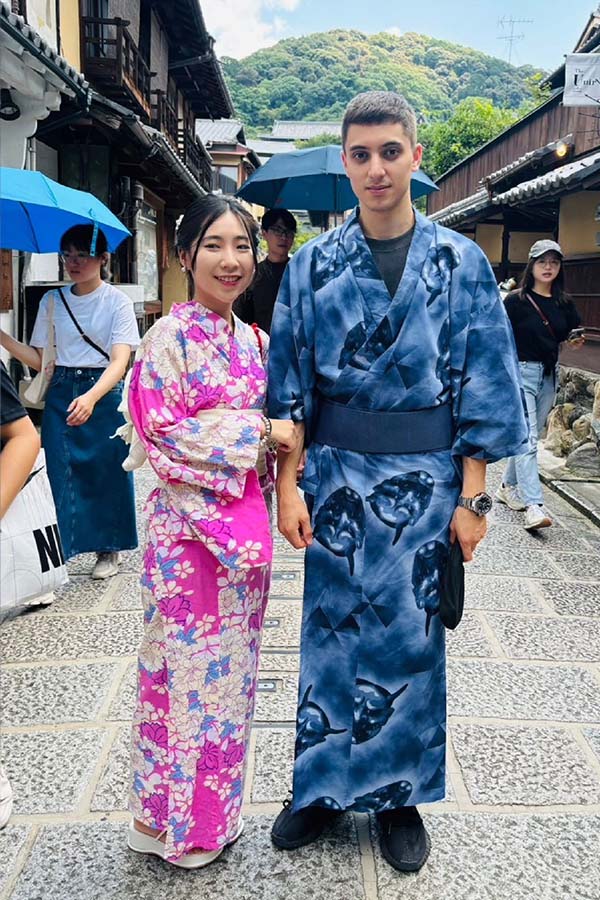
- Why Wear Yukata in Summer Despite the Heat?
- Understanding Japanese Fireworks Festivals (Hanabi Taikai)
- The Art of Japanese Hanabi: Five-Second Masterpieces
- Top 10 Kimono Experiences in Japan
- 1. Kyoto: The Cultural Heart
- 2. Tokyo Asakusa: Traditional Meets Modern
- 3. Nara: Ancient Capital Charm
- 4. Osaka: Vibrant Festival Culture
- 5. Hakone: Hot Springs and Mountain Views
- 6. Nikko: UNESCO World Heritage
- 7. Kamakura: Seaside Traditions
- 8. Hiroshima: Peace and Remembrance
- 9. Takayama: Mountain Village Charm
- 10. Kanazawa: Artisan Culture
- Complete Guide to Yukata Comfort in Summer Heat
- Best Fireworks Festivals Calendar: When and Where
- Etiquette and Cultural Customs
- Photography Tips for Your Yukata Experience
- Where to Find the Perfect Yukata
- Making Memories That Last
- Conclusion: Embrace the Magic of Japanese Summer
- Frequently Asked Questions
- Is it appropriate for foreigners to wear yukata?
- How much does yukata rental cost?
- Can I wear yukata if I’m not attending a festival?
- How early should I book yukata rental?
- Are there age restrictions for wearing yukata?
- What should I do if it rains during a festival?
- Can I wash my own yukata if I purchase one?
- Are there specific colors I should avoid?
Why Wear Yukata in Summer Despite the Heat?
Wearing a yukata in summer might seem counterintuitive given Japan’s notoriously humid weather, but this practice represents the heart of Japanese summer culture. The tradition of donning yukata during summer festivals creates an authentic cultural bridge that transforms visitors from mere observers into active participants in Japan’s living heritage.
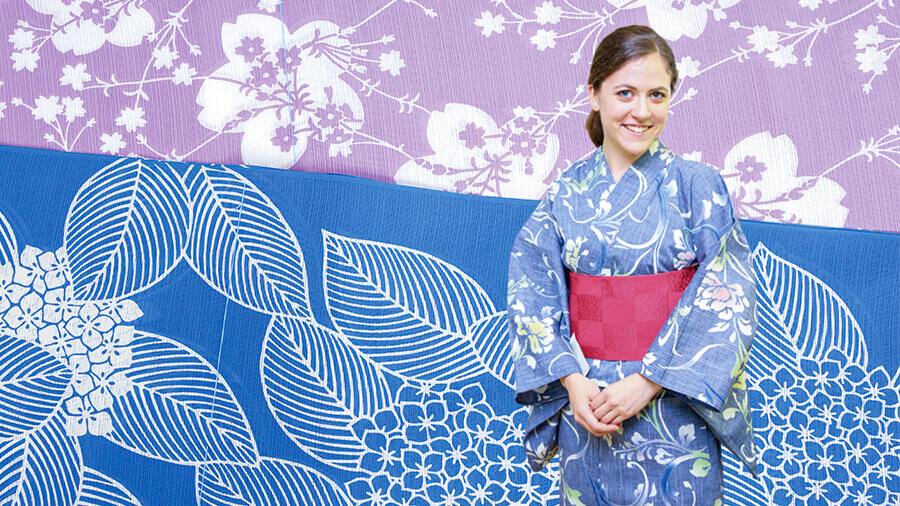
The Science Behind Summer Kimono Comfort
Modern yukata design incorporates centuries of textile wisdom specifically engineered for Japan’s hot summers. These summer kimonos feature:
- Lightweight cotton construction that promotes airflow
- Loose-fitting silhouettes that prevent fabric from clinging to skin
- Breathable weaving techniques that allow heat to escape
- Moisture-wicking properties that keep wearers comfortable
The cotton yukata serves as more than just traditional attire—it’s a sophisticated cooling system developed through generations of Japanese textile innovation.
Cultural Significance of Festival Attire
Participating in Japanese festivals while wearing yukata creates a profound connection to cultural traditions dating back over 1,000 years. This practice:
- Honors historical customs and ancestral wisdom
- Creates visual harmony among festival participants
- Enhances the communal festival experience
- Demonstrates respect for Japanese cultural values
- Provides Instagram-worthy photo opportunities
The Psychology of Cultural Immersion
Research shows that wearing traditional clothing during cultural events increases emotional connection and memory formation. When you don yukata at fireworks festivals, you’re not just dressing up—you’re participating in a centuries-old ritual that connects you to millions of Japanese people who have shared this same experience.
Understanding Japanese Fireworks Festivals (Hanabi Taikai)
Japanese fireworks festivals, known as “Hanabi Taikai,” represent one of Japan’s most beloved summer traditions. These events combine pyrotechnic artistry with cultural celebration, creating experiences that captivate both locals and international visitors.
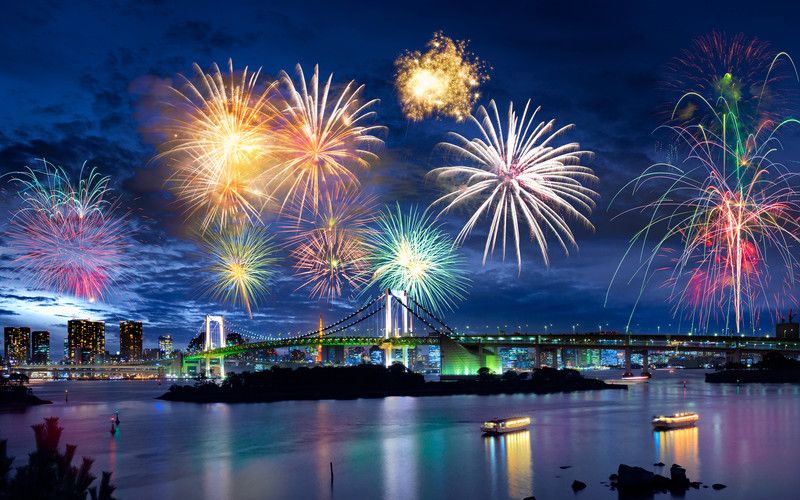
The History of Hanabi Taikai
The tradition of Japanese fireworks began in the 18th century during the Edo period. Originally created to ward off evil spirits and commemorate the deceased, these festivals evolved into celebrations of life, community, and artistic expression. Today, over 300 major fireworks festivals occur across Japan each summer.
What Makes Japanese Fireworks Unique
Japanese hanabi differs significantly from Western fireworks displays:
- Artistic choreography synchronized to music
- Intricate patterns that form shapes like chrysanthemums, willows, and hearts
- Color gradations that shift from one hue to another mid-explosion
- Storytelling elements that convey emotions and themes
- Community participation where audiences actively engage
The Festival Experience Beyond Fireworks
Japanese summer festivals offer comprehensive cultural experiences:

Traditional Food Culture
- Takoyaki (octopus balls) – crispy exterior, creamy interior
- Yakitori (grilled chicken skewers) – seasoned with tare sauce
- Kakigori (shaved ice) – flavored with seasonal syrups
- Taiyaki (fish-shaped pastries) – filled with sweet red bean paste
- Yakisoba (stir-fried noodles) – a festival staple
Traditional Games and Activities
- Kingyo-sukui (goldfish scooping) – requires skill and patience
- Yo-yo fishing – children’s favorite water balloon game
- Ring toss – traditional carnival-style games
- Shooting galleries – win prizes with precision
- Fortune telling – discover your summer destiny
Cultural Performances
- Taiko drumming – thunderous rhythms that energize crowds
- Traditional dance – graceful movements in yukata
- Folk music – regional songs passed down through generations
- Storytelling – ancient tales under lantern light
The Art of Japanese Hanabi: Five-Second Masterpieces
Japanese fireworks represent an ephemeral art form where each explosion becomes a fleeting masterpiece illuminating the night sky. These “five-second artworks” demonstrate the Japanese aesthetic principle of mono no aware—the bittersweet beauty of impermanence.
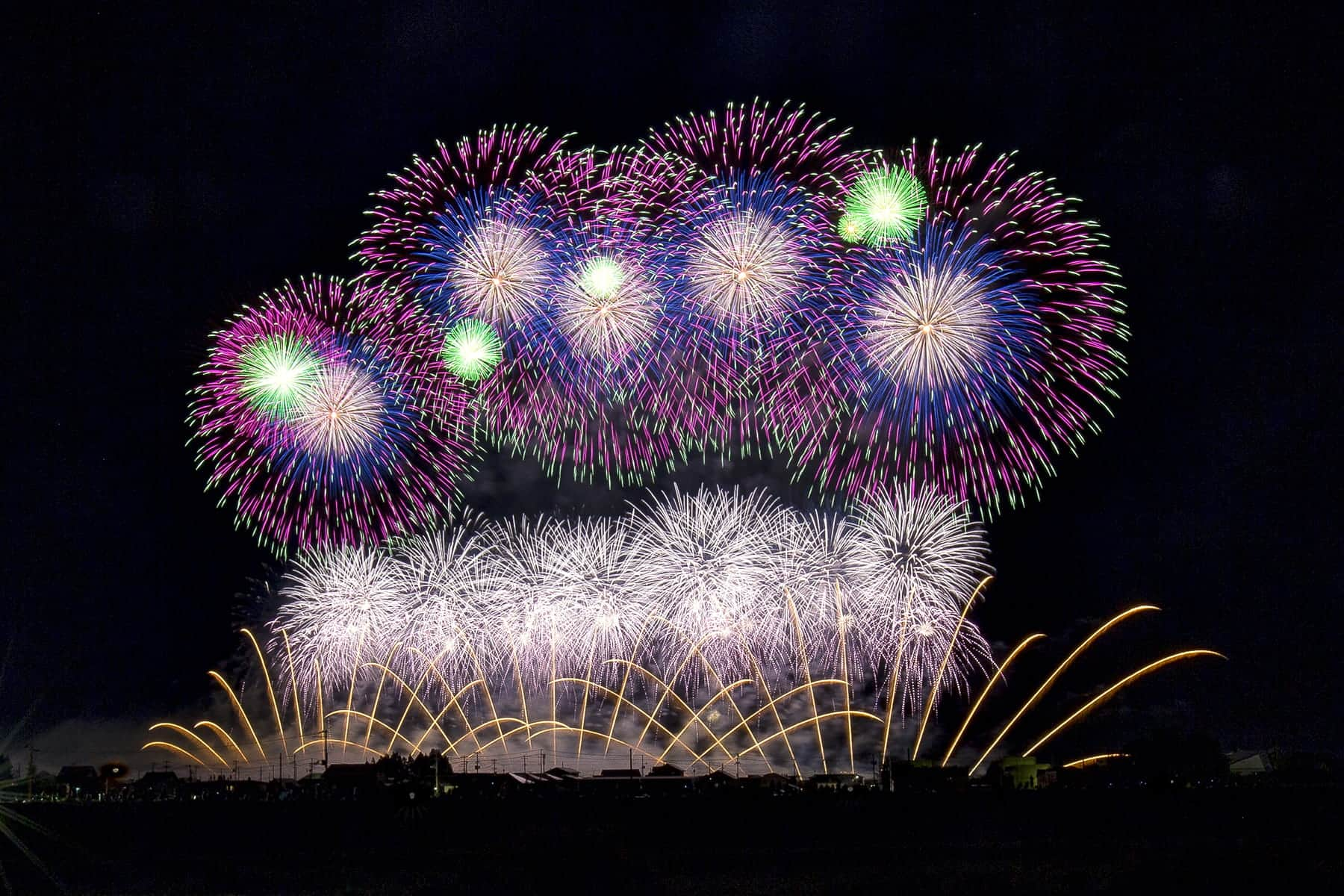
The Craftsmanship Behind Each Firework
Creating Japanese hanabi requires masterful skill passed down through generations:
Shell Construction
- Precise gunpowder ratios determine explosion patterns
- Star arrangement creates specific visual effects
- Timing mechanisms control sequence and duration
- Color chemistry produces vibrant, shifting hues
Artistic Categories
- Chrysanthemum (Kiku) – symmetrical bursts resembling flowers
- Willow (Yanagi) – drooping trails like tree branches
- Ring (Wa) – perfect circles expanding outward
- Heart (Heart) – romantic shapes for special occasions
- Character (Moji) – forming letters or symbols
The Emotional Impact of Hanabi
Japanese fireworks festivals create profound emotional experiences through:
- Collective gasps when spectacular displays appear
- Shared anticipation before grand finale sequences
- Cultural unity among diverse festival participants
- Childhood nostalgia for returning Japanese visitors
- Wonder and amazement for first-time international guests
Photography Opportunities
Capturing fireworks photography while wearing yukata creates stunning visual narratives. The contrast between traditional clothing and modern pyrotechnics produces images that tell stories of cultural continuity and celebration.
Top 10 Kimono Experiences in Japan
Japan offers countless opportunities to wear traditional kimono in breathtaking settings. Each location provides unique cultural contexts that enhance your understanding of Japanese aesthetics and history.

1. Kyoto: The Cultural Heart
Kyoto kimono experiences remain unparalleled for cultural authenticity. The ancient capital offers:
- Gion district – spot geishas in their natural environment
- Fushimi Inari shrine – thousands of red torii gates
- Arashiyama bamboo grove – mystical green tunnels
- Kiyomizu-dera temple – panoramic city views
- Philosopher’s Path – cherry tree-lined walkways
2. Tokyo Asakusa: Traditional Meets Modern
Tokyo kimono rental in Asakusa provides urban cultural immersion:
- Senso-ji temple – Tokyo’s oldest Buddhist temple
- Nakamise shopping street – traditional crafts and snacks
- Sumida River – perfect for fireworks festival viewing
- Tokyo Skytree views – modern architecture backdrop
- Traditional restaurants – authentic kaiseki dining
3. Nara: Ancient Capital Charm
Nara kimono experiences combine history with natural beauty:
- Todai-ji temple – housing the giant Buddha statue
- Nara Park – interact with sacred deer
- Kasuga Taisha shrine – thousands of stone lanterns
- Traditional tea houses – authentic matcha ceremonies
4. Osaka: Vibrant Festival Culture
Osaka kimono rental offers dynamic urban experiences:
- Osaka Castle – reconstructed historical landmark
- Dotonbori district – neon-lit entertainment quarter
- Sumiyoshi Taisha shrine – ancient Shinto architecture
- Kuromon Ichiba market – street food paradise
5. Hakone: Hot Springs and Mountain Views
Hakone kimono experiences provide natural serenity:
- Lake Ashi – scenic crater lake views
- Hakone Shrine – iconic red torii in water
- Traditional ryokan – hot spring resort experiences
- Mount Fuji views – Japan’s sacred mountain
6. Nikko: UNESCO World Heritage
Nikko kimono rental offers spiritual experiences:
- Toshogu Shrine – elaborate Edo-period architecture
- Kegon Falls – spectacular waterfall views
- Sacred bridges – traditional architectural marvels
- Mountain temples – peaceful meditation settings
7. Kamakura: Seaside Traditions
Kamakura kimono experiences blend history with coastal beauty:
- Great Buddha statue – bronze colossus from 1252
- Hase-dera temple – stunning ocean views
- Bamboo forests – tranquil walking paths
- Traditional gardens – seasonal flower displays
8. Hiroshima: Peace and Remembrance
Hiroshima kimono rental provides meaningful cultural contexts:
- Peace Memorial Park – reflective historical sites
- Itsukushima Shrine – famous floating torii gate
- Miyajima Island – sacred island experiences
- Traditional performances – cultural preservation
9. Takayama: Mountain Village Charm
Takayama kimono experiences offer rural authenticity:
- Preserved old town – Edo-period streetscapes
- Sake breweries – traditional alcohol production
- Mountain festivals – seasonal celebrations
- Farm stays – authentic rural experiences
10. Kanazawa: Artisan Culture
Kanazawa kimono rental showcases traditional crafts:
- Kenroku-en Garden – one of Japan’s three most beautiful gardens
- Geisha districts – active traditional entertainment quarters
- Gold leaf workshops – hands-on craft experiences
- Traditional markets – local artisan products
Complete Guide to Yukata Comfort in Summer Heat
Wearing yukata comfortably during Japan’s humid summers requires strategic planning and proper technique. Follow these expert tips to stay cool while looking authentic.
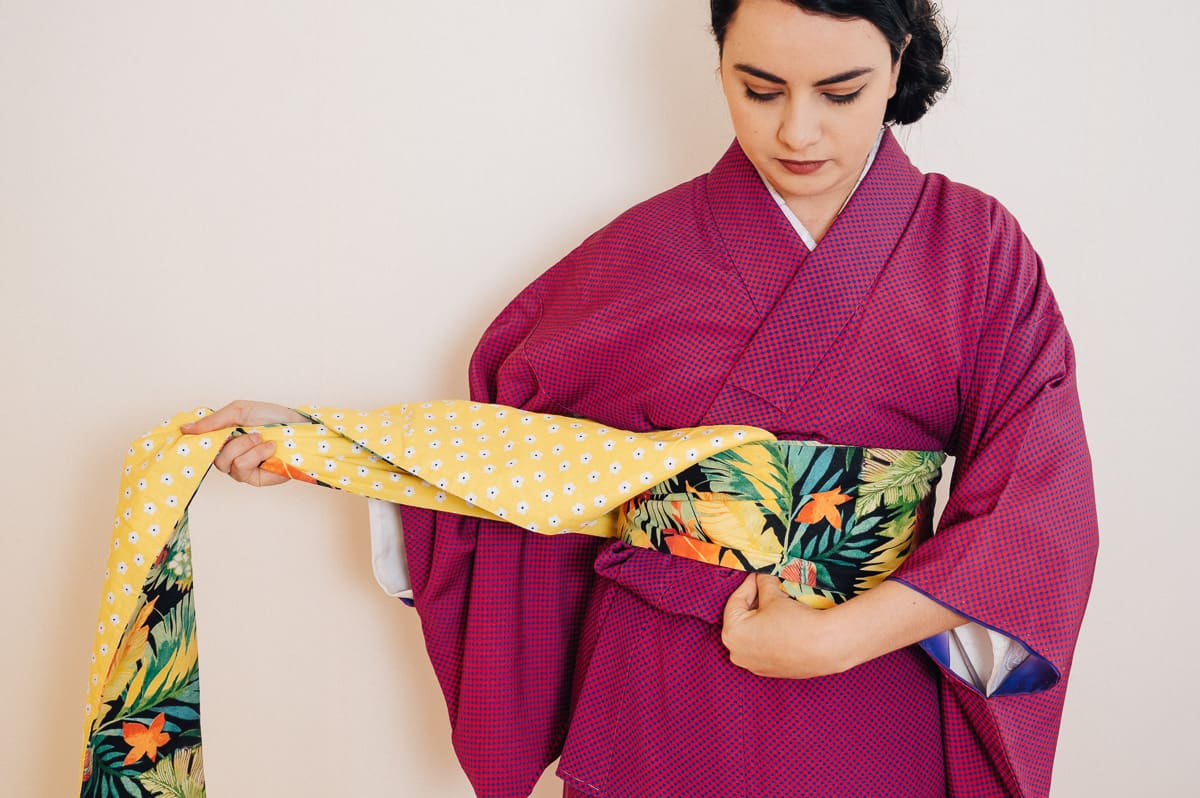
Fabric Selection for Maximum Comfort
Cotton Varieties
- Tencel-cotton blends – superior moisture-wicking properties
- Organic cotton – softer texture, better breathability
- Linen-cotton combinations – ultimate cooling properties
- Bamboo fiber cotton – antimicrobial and temperature-regulating
Color Psychology and Heat Management
- Light colors reflect sunlight and reduce heat absorption
- Pastels provide cooling visual effects
- White and cream offer maximum heat reflection
- Avoid dark colors which absorb and retain heat
Layering Strategies for Hot Weather
Undergarments
- Sarashi (chest wrapping) instead of heavy undergarments
- Moisture-wicking underclothes for sweat management
- Minimal layering to prevent overheating
- Breathable fabrics against skin
Accessories for Comfort
- Traditional fans (uchiwa) – functional and aesthetic
- Cooling towels – discreet sweat management
- Portable fans – modern convenience in traditional settings
- Hydration accessories – water bottles with traditional designs
Professional Dressing Techniques
Proper Obi Tying
- Loose tension to allow airflow
- Breathable obi materials like cotton or linen
- Simple knots that don’t create pressure points
- Adjustable techniques for comfort throughout the day
Movement and Posture
- Shorter steps to prevent fabric restriction
- Graceful arm movements that don’t disturb the garment
- Sitting techniques that maintain kimono integrity
- Walking rhythm that feels natural in traditional footwear
Best Fireworks Festivals Calendar: When and Where
Planning your Japanese fireworks festival experience requires understanding the seasonal timing and regional specialties. Here’s your comprehensive guide to Japan’s premier summer celebrations.

July Fireworks Festivals
Tokyo Area
Sumida River Fireworks Festival (Last Saturday of July)
- Location: Sumida River, Tokyo
- Attendance: Over 950,000 people
- Highlights: 20,000 fireworks, competitive displays
- Best viewing: Asakusa and Honjo areas
- Yukata rental: Abundant options in Asakusa
Edogawa Fireworks Festival (First Saturday of August)
- Location: Edogawa River, Tokyo
- Attendance: Over 700,000 people
- Highlights: 14,000 fireworks, eight-second continuous explosions
- Best viewing: Both Tokyo and Chiba sides
- Photography: Excellent riverside vantage points
Kansai Region
Osaka Tenjin Matsuri (July 24-25)
- Location: Osaka, Okawa River
- Attendance: Over 1.3 million people
- Highlights: 5,000 fireworks, traditional boat processions
- Cultural significance: One of Japan’s three greatest festivals
- Yukata wearing: Essential for authentic participation
August Fireworks Festivals
Niigata Prefecture
Nagaoka Fireworks Festival (August 2-3)
- Location: Shinano River, Nagaoka City
- Attendance: Over 1 million people
- Highlights: “Phoenix” memorial display, 2km-wide “Niagara Falls”
- Historical significance: Post-war reconstruction memorial
- Accommodation: Book months in advance
Akita Prefecture
Omagari Fireworks Festival (Fourth Saturday of August)
- Location: Omagari, Daisen City
- Attendance: Over 800,000 people
- Highlights: National fireworks competition
- Judging criteria: Technical skill, artistic merit, originality
- Winner recognition: Prestigious national honor
Regional Specialties and Unique Features
Hokkaido Summer Festivals
- Sapporo: Cool temperatures, comfortable yukata wearing
- Hakodate: Harbor setting, romantic atmosphere
- Chitose: Airport accessibility for international visitors
Kyushu Fireworks Culture
- Kumamoto: Traditional castle backdrop
- Kagoshima: Volcano views during displays
- Fukuoka: Urban sophistication meets tradition
Etiquette and Cultural Customs
Understanding Japanese festival etiquette enhances your experience and demonstrates respect for local customs. These guidelines ensure you’ll be welcomed warmly by Japanese participants.
Kimono Wearing Etiquette
Proper Wearing Technique
- Left over right – crucial cultural rule (right over left reserved for deceased)
- Collar spacing – three fingers’ width from neck
- Hemline length – touching ankles, not dragging
- Sleeve positioning – hanging naturally, not pulled
Behavior in Yukata
- Smaller steps – maintain elegant posture
- Gentle movements – avoid sudden gestures
- Sitting gracefully – kneel or sit on edge of seats
- Eating carefully – protect sleeves from food
Festival Participation Guidelines
Crowd Navigation
- Follow the flow – don’t push against pedestrian traffic
- Maintain personal space – respect others’ comfort zones
- Help others – assist with directions or translation
- Stay aware – watch for lost children or elderly needing help
Food and Drink Etiquette
- Eat at stalls – don’t walk while eating
- Dispose properly – use designated trash areas
- Share experiences – offer tastes to companions
- Appreciate vendors – thank food stall operators
Photography and Social Media
Respectful Photography
- Ask permission – before photographing people in yukata
- Avoid flash – during fireworks displays
- Respect privacy – don’t photograph private moments
- Share positively – promote Japanese culture respectfully
Social Media Guidelines
- Tag locations – help promote local festivals
- Use appropriate hashtags – #JapanFireworks #YukataStyle #JapaneseFestival
- Credit sources – mention helpful locals or businesses
- Avoid complaints – focus on positive experiences
Photography Tips for Your Yukata Experience
Capturing stunning fireworks photography while wearing yukata requires technical knowledge and cultural sensitivity. Professional photographers share these insider secrets for creating memorable images.
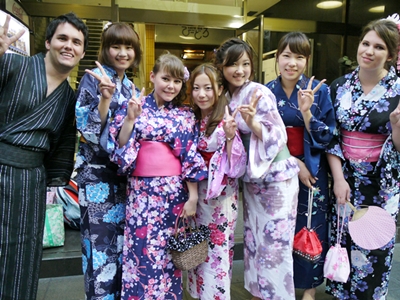
Technical Camera Settings
Fireworks Photography Basics
- Manual mode – full control over exposure
- Low ISO (100-400) – minimize noise
- Small aperture (f/8-f/16) – sharp details
- Long exposure (2-6 seconds) – capture light trails
- Tripod essential – prevent camera shake
Yukata Portrait Photography
- Golden hour lighting – soft, flattering illumination
- Fill flash – balance subject and background
- Shallow depth of field – blur distracting backgrounds
- Eye-level angles – create connection with viewers
- Natural poses – authentic cultural moments
Composition Techniques
Environmental Storytelling
- Include festival context – food stalls, crowds, decorations
- Show scale – fireworks against city skylines
- Capture emotions – wonder, excitement, cultural pride
- Document traditions – traditional games, performances
- Preserve memories – candid moments with friends
Creative Perspectives
- Low angles – dramatic yukata silhouettes
- Reflection shots – fireworks in water surfaces
- Crowd interactions – shared cultural experiences
- Detail shots – obi knots, traditional accessories
- Motion blur – festival energy and movement
Professional Photography Services
For those seeking professional-quality images of their Japanese cultural experience, consider booking a dedicated photography session. AllPhoto Kyoto specializes in capturing authentic moments during your kimono and festival experiences. Their photographers understand both technical requirements and cultural nuances, ensuring your memories are preserved beautifully.
Professional photography sessions offer:
- Expert guidance on poses and locations
- High-quality equipment for optimal results
- Cultural knowledge for authentic styling
- Edited images ready for social media
- Printed packages for lasting keepsakes
Where to Find the Perfect Yukata
Securing the ideal yukata rental or purchase requires understanding your options and planning ahead. Japan offers numerous approaches to finding your perfect summer kimono.

Rental Options and Services
Traditional Rental Shops
- Full-service packages – yukata, obi, accessories, dressing service
- Professional styling – hair arrangement, makeup options
- Multiple locations – tourist areas, train stations
- Advance booking – essential during festival season
- Return flexibility – extended hours during festivals
Modern Rental Platforms
- Online booking – reserve before arrival
- Size variety – accommodating international body types
- Style choices – traditional patterns to modern designs
- Price transparency – clear pricing without hidden fees
- Customer reviews – authentic feedback from previous renters
Purchase Considerations
New Yukata Shopping
- Department stores – quality guarantee, variety
- Specialty kimono shops – expert advice, authentic pieces
- Online retailers – convenience, competitive pricing
- Festival vendors – unique, seasonal designs
- Tourist areas – English-speaking staff, international shipping
Vintage and Antique Options
- Antique markets – unique historical pieces
- Consignment shops – high-quality used kimono
- Estate sales – rare finds, authentic provenance
- Online auctions – competitive pricing, rare patterns
- Collector communities – expert authentication, networking
Sizing and Fitting Guidelines
Understanding Japanese Sizing
- Measurements differ – from Western clothing standards
- Adjustability – obi and ties accommodate size variations
- Length considerations – height adjustments possible
- Sleeve lengths – age-appropriate traditional styles
- Professional fitting – recommended for purchase
Making Memories That Last
Your Japanese summer festival experience extends beyond the event itself. Creating lasting memories requires intentional preparation and mindful participation.
Pre-Festival Preparation
Cultural Education
- Learn basic Japanese phrases – enhance interactions
- Understand festival history – appreciate cultural significance
- Research local customs – demonstrate respect
- Study yukata traditions – wear with confidence
- Plan photography strategy – capture meaningful moments
Practical Preparation
- Weather monitoring – prepare for heat and humidity
- Hydration strategy – stay healthy during long events
- Comfort items – fans, cooling towels, comfortable shoes
- Emergency contacts – safety in crowded environments
- Transportation planning – avoid post-festival crowds
During the Festival
Mindful Participation
- Engage with locals – practice cultural exchange
- Try traditional foods – expand culinary horizons
- Participate in activities – games, performances, traditions
- Document experiences – photos, videos, journal entries
- Stay present – enjoy moments without constant phone use
Cultural Appreciation
- Observe quietly – respect ceremonial moments
- Ask questions – locals love sharing cultural knowledge
- Show gratitude – thank people for their kindness
- Participate respectfully – follow local customs
- Spread positivity – represent international visitors well
Post-Festival Reflection
Memory Preservation
- Organize photos – create digital albums
- Write experiences – journal about cultural insights
- Share stories – inspire others to visit Japan
- Maintain connections – stay in touch with new friends
- Plan return visits – Japan’s festivals vary by season
Cultural Integration
- Continue learning – study Japanese language or culture
- Support Japanese businesses – in your home country
- Share knowledge – teach others about Japanese traditions
- Collect authentic items – build meaningful collections
- Inspire others – encourage cultural exploration
Conclusion: Embrace the Magic of Japanese Summer
Experiencing Japanese summer festivals while wearing traditional yukata creates transformative memories that last a lifetime. This unique cultural immersion connects you to centuries of Japanese tradition while providing modern entertainment and social connection.
The combination of Japanese fireworks, traditional clothing, authentic food, and cultural participation creates an experience that engages all your senses and emotions. Whether you’re watching the spectacular hanabi displays illuminate the night sky or participating in traditional festival games, your yukata connects you to the living heritage of Japan.
Remember that this experience extends beyond simple tourism—it’s an opportunity for genuine cultural exchange and personal growth. By respectfully participating in these traditions, you become part of Japan’s ongoing cultural narrative while creating memories that will inspire your future adventures.
Plan your Japanese summer festival experience today, and discover why millions of people around the world consider these events among the most magical cultural experiences available anywhere on Earth.
Frequently Asked Questions
Is it appropriate for foreigners to wear yukata?
Yes, Japanese people generally appreciate when foreigners wear yukata respectfully at festivals. It demonstrates cultural interest and respect.
How much does yukata rental cost?
Yukata rental typically ranges from ¥3,000-¥8,000 ($20-$55) including accessories and basic styling services.
Can I wear yukata if I’m not attending a festival?
While yukata are primarily festival wear, they’re also appropriate for summer evening events, traditional restaurants, and cultural experiences.
How early should I book yukata rental?
During peak festival season (July-August), book at least 2-3 days in advance, or earlier for popular festivals.
Are there age restrictions for wearing yukata?
No age restrictions exist. Children, adults, and elderly people all wear yukata at festivals.
What should I do if it rains during a festival?
Most festivals continue in light rain. Bring an umbrella and consider waterproof foot covers for traditional sandals.
Can I wash my own yukata if I purchase one?
Yes, cotton yukata can be hand-washed gently in cold water. Professional cleaning is recommended for silk pieces.
Are there specific colors I should avoid?
While most colors are acceptable, extremely bright or neon colors might look out of place at traditional festivals.
Ready to capture your perfect Japanese summer memories? Book your professional photography session with AllPhoto Kyoto and preserve your yukata experience with stunning, authentic images that you’ll treasure forever.



コメント